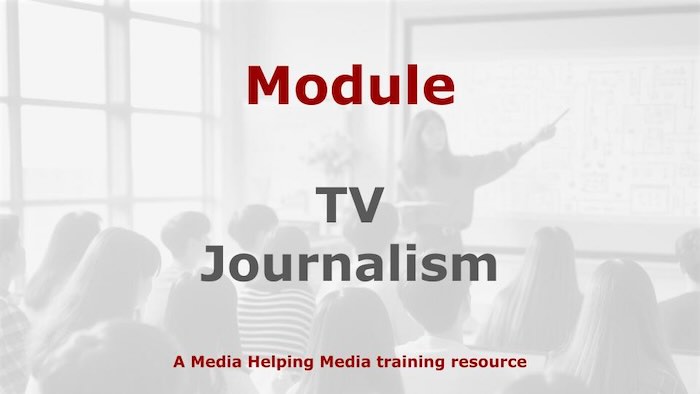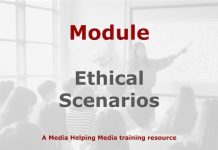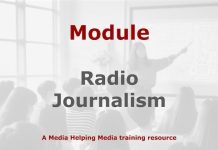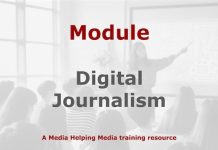 This six-week training module provides an outline for teaching students TV journalism skills from writing news scripts to producing TV news and current affairs programmes.
This six-week training module provides an outline for teaching students TV journalism skills from writing news scripts to producing TV news and current affairs programmes.
It’s designed to be adapted by college and university lecturers to address local teaching requirements.
Each week introduces a core area of TV journalism, with direct links to the relevant resources. The module builds from foundational skills to advanced production and ethical considerations, reflecting best practice in broadcast journalism.
Week 1: Constructing TV news packages
- Focus: Students will be introduced to the structure and essential elements of a TV news package. They will learn how to combine visuals, interviews, voice-overs, and stand-ups to create compelling stories for television.
- What to expect: The session covers the basics of planning, gathering footage, scripting, and editing. Students will explore the workflow from idea to finished package, including the importance of news values and editorial decision-making. Practical exercises will involve analysing sample packages and outlining their own.
- Resources:
Week 2: Scriptwriting and visual storytelling
- Focus: This week centres on the craft of writing scripts for television, with an emphasis on letting the pictures tell the story. Students will learn how to write concise, clear, and engaging scripts that complement the visuals rather than compete with them.
- What to expect: The session explores techniques for scripting around pictures, using natural sound, and structuring stories for maximum impact. Students will practise writing scripts for real news events and receive feedback on how well their words work with images.
- Resources:
Week 3: Interviewing for TV
- Focus: Students will develop the skills needed to conduct effective interviews for television. This includes preparation, questioning techniques, and understanding the visual dynamics of on-camera interviews.
- What to expect: The session covers how to put interviewees at ease, frame shots, and elicit strong, newsworthy responses. Students will also discuss ethical considerations and the importance of understanding interviewee motivations. Practical exercises will involve role-play and recording mock interviews.
- Resources:
Week 4: The role of the news producer and brand values
- Focus: This week introduces the newsroom environment, the responsibilities of the TV news producer, and the importance of brand values in broadcast news.
- What to expect: Students will learn about the producer’s role in managing teams, making editorial decisions, and ensuring programmes reflect the station’s identity and values. The session also explores how to maintain consistency, trust, and credibility in news output.
- Resources:
Week 5: Documentary and current affairs production
- Focus: Students will explore the process of creating in-depth documentaries and current affairs programmes for television.
- What to expect: The session covers topic selection, research, narrative structure, and the differences between news packages and longer-form storytelling. Students will learn about the planning, filming, scripting, and editing stages, as well as the ethical and legal issues involved in investigative reporting.
- Resources:
Week 6: Photojournalism, ethics, and visual integrity
- Focus: The final week addresses the ethical responsibilities of TV journalists, with a focus on photojournalism and the use of images in news.
- What to expect: Students will examine real-world case studies of ethical dilemmas, discuss the impact of images on public perception, and learn about consent, privacy, and manipulation. The session encourages critical thinking about the journalist’s duty to report truthfully while respecting ethical boundaries.
- Resources:
Summary
This module provides a clear, progressive structure for developing the core skills of a TV broadcast journalist. Each week blends theory with practical exercises, preparing students for the demands of a modern newsroom and the ethical challenges of visual reporting. All resources are directly linked to the original articles on Media Helping Media for further reading and study.








